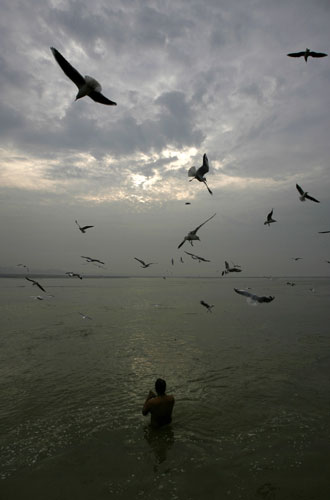It’s Holy Week and Passover, so naturally I thought of the river Ganges. A crescent moon over the river would have been a nice touch, but that’s not a picture you see often. With this bit of irreverence, we have four great faiths and secularism in play, but the question of which image to use didn’t get any easier. That’s when convention comes to the rescue, and there is a typical image of the Ganges as a spiritual symbol. This photograph provides one version of that stock image.

Someone is walking into the great river for a devotional immersion. The human being is naked or nearly so. The river is calm, dark, and expansive. The human being is vulnerable, small, singular; the river appears enormous and eternal. It is easy to imagine it as “The swarthy water/That flows round the earth and through the skies,/Twisting among the universal spaces” (Wallace Stevens). This cosmic flow of being envelops all, and we see ourselves standing apart from it only briefly, while lost in illusion.
This photograph captures that sense of isolation and yearning against a horizon of eternal being. It adds a somewhat darker inflection as well: the birds can suggest that the body below them is so much carrion, while the murky clouds imply a universe that is pitched toward obliteration rather than salvation. The river is eternal, flowing outward and back, absorbing all of creation, and the best the individual human being might find is calmness, serenity, the peace that comes from passing into nothingness.
But like I said, that’s a conventional view of the river. And here’s a different view:

This view of the river was taken during the Ganga Dussehra festival in Haridwar, a city whose name means “Gateway to God.” One might title it “I sing the river electric,” except that some of the lights are oil lamps. It is ablaze with light and energy of every sort, and so seems to be a very different river from the one above. Thronged with people, this is no place for solitude. Lights, pavilions, and other delights clamor for attention, and the river becomes a conduit for the many flows of social life: commerce, religion, entertainment, arts, technologies, and sheer human hubbub press against the banks and surge down the channel. This river carries civilizations, each of which will continue in some way in those that supersede it.
Some will want to point out that the second river already is encompassed by the first, and that any celebration of the vitality along the banks is only another example of being distracted by the veil of illusion. But one also could say that the first river is a part of the second, one of the many ways to understand life, but not the only way of life available. Rivers have birthed many cities, and the cities themselves become great channels of human energy, and human diversity.
It may be reassuring, even a source of spiritual solace to imagine the Ganges as a river of eternal return. That is not the only Ganges, however, or the nature of India. During a time of spiritual reflection, let’s also marvel at the vitality of the human world this side of eternity.
Photographs by Rajesh Kumar Singh/Associated Press and John Stanmeyer, VII/National Geographic. The Stevens’ quotation is from his poem, Metaphor as Degeneration.
That second pic is amazing